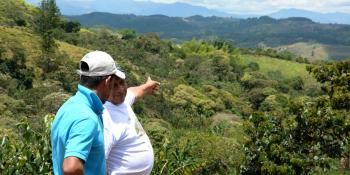Working backwards to plan for future food security in East Africa

How do technical advisors to policy makers in East Africa view the region in 2020 and 2030? Will they come up with drastically different scenarios from those in civil society who participated in the scenarios visioning workshop in Nairobi in June 2012?
These kinds of questions were explored in the East Africa Strategic Futures Workshop that was held in Arusha, Tanzania and hosted by the CGIAR Research Program on Climate Change, Agriculture and Food Security (CCAFS), in partnership with the Society for International Development and Panos Eastern Africa. Read more about the previous scenarios workshop held in Nairobi, Kenya, “Exploring regional strategies for a more sustainable, food secure East Africa”.
Over two and half days, participants from various ministries in Kenya, Tanzania, Uganda, Rwanda, Burundi, and Ethiopia developed a strategic vision of the future and explored feasible strategies towards this vision by testing them using scenarios of plausible alternate futures. Although the main aim of the workshop was to develop a shared vision of the future of East Africa on governance, environment, food security, and livelihoods, there were two key outcomes of the workshop. These included co-learning about scenario methodologies and potential partnerships among participants that could lead to policy implementation in the region based on the scenarios
Scenario development within East Africa is still largely a new concept and way of planning and creating policies. This scenarios workshop allowed participants to learn how to develop regional strategies through the method of “back-casting”. Back-casting involves working back from a co-created desired future to the present. The advantage of back-casting is that it takes strategic planners away from planning forward to the future, which usually leads to plans that build on and plan for the past, rather than for the future. Many described this learning process as “challenging” and a “brain teaser” since it is not common to work backwards since planning for the future intuitively suggests working forward.
Co-learning about scenarios development and co-creating future visions allowed for a great deal of interaction and group work during the workshop. Ice breakers such as “speed meets” allowed participants to get to know one another where information was shared on how each participants would like East Africa to look in an ideal case. It also allowed participants to share what they think would challenge citizens of the region. Such workshop strategies allowed participants, many whom who have never met before, to develop partnerships by the end of the workshop. These potential partnerships were mapped onto key strategies and policies viewed as implementable and identified by the participants. It is anticipated that this process will allow to make partnerships even more concrete and active. In order to keep participation and partnership development process going, CCAFS has established a wiki-space where participants can virtually join discussions.
A combination of intellectual engagement in a participatory manner, co-learning about scenario methodology, and partnership development has led many to feel that this scenarios visioning workshop was worthwhile. Many participants have stated that they will now inform their decision makers in various ministries of not only the value of scenarios but also the process of co-producing them.
The East Africa Strategic Futures Workshop Report will be available soon online.
This blog post was written by Moushumi Chaudhury, Science Officer at the CGIAR Research Program on Climate Change, Agriculture and Food Security (CCAFS). To get more updates on our scenarios research, follow us on Facebook, and Twitter @Cgiarclimate.



